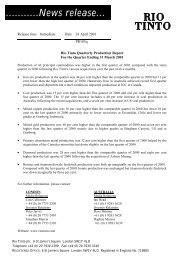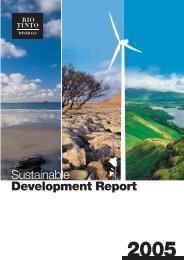Luzenac - Rio Tinto
Luzenac - Rio Tinto
Luzenac - Rio Tinto
Create successful ePaper yourself
Turn your PDF publications into a flip-book with our unique Google optimized e-Paper software.
14<br />
TLF’s new camera analyses<br />
the colour of the talc at a rate<br />
of 3,000 particles per second.<br />
Making the most<br />
efficient use<br />
of our mineral<br />
deposits<br />
<strong>Luzenac</strong> is currently testing thow out<br />
technology on its roller mills in several<br />
of its operations. The results are extremely<br />
promising.<br />
2003 goals and targets<br />
Objectives for 2003 include:<br />
- extending throw-out technology<br />
to the roller mills at our Talc de<br />
<strong>Luzenac</strong> France plant;<br />
- completing the ore sorter<br />
project study at our Three<br />
Springs operation in Australia;<br />
- optimising our existing friction<br />
sorting system at our<br />
Yellowstone operation<br />
in Montana, USA.<br />
Some argue that if you exploit a finite resource<br />
then, by definition, your activity cannot be sustainable.<br />
At <strong>Luzenac</strong>, we believe that reality is<br />
more complex than that.<br />
Human life could not exist as we know it if we did<br />
not take geological resources from the Earth. We<br />
consider acceptability to be a question of abundance<br />
of the mineral, the degree of damage caused (environmental<br />
and social) in mining and processing it,<br />
the efficiency of the extraction method and opportunities<br />
for recycling. Talc is beneficial in meeting<br />
human needs today and the indications are that we<br />
will be able to meet those needs for centuries to<br />
come. Due to the nature of the mineral, talc can be<br />
mined and processed without significant harm to<br />
people or the environment. In its major applications,<br />
talc is not only recyclable, it contributes to the environmental<br />
friendliness of the end product itself. If<br />
the rule were that all mineral resources should be<br />
left in the ground for future generations, then life as<br />
we know it would be impossible. And if this rule were<br />
right for us, then surely it would be right for future<br />
generations too!<br />
Nonetheless, it is our responsibility to ensure that<br />
we make the most efficient use of the resources we<br />
own. <strong>Luzenac</strong> has been seeking ways to do this for<br />
many years now and uses a number of state-of-theart<br />
processes, such as optical and friction sorting, in<br />
its mine operations to ensure that ore recovery is<br />
maximised.<br />
In 2002, we completed or initiated a number of projects<br />
designed to optimise our extraction processes.<br />
Ore sorting<br />
Our French operation has been using optical sorting<br />
to optimise ore resources for the last twenty<br />
years. In 2002, Talc de <strong>Luzenac</strong> France (TLF) installed<br />
a new-generation optical sorter with a highresolution<br />
camera able to detect rock particles as<br />
small as five millimetres at a rate of 3,000 particles<br />
per second. This has allowed us to considerably<br />
increase recovery of white ore, enabling us<br />
to reduce the total number of tons of ore we<br />
extract from the ground by nearly 10%. TLF is now<br />
ready to produce pure, white “000” grade talcs,<br />
particularly suited to the pharmaceuticals industry.<br />
<strong>Luzenac</strong> Australia’s Three Springs Mine produces<br />
around 150,000 tons per year of lump microcrystalline<br />
talc in six different grades. After a selective mining<br />
operation based on colour and mineralogy criteria,<br />
followed by a crushing and sizing operation, the ore<br />
is refined by hand sorting on a picking belt in order<br />
to remove accessory minerals present in the talc. The<br />
hand-sorting process is inefficient and results in low<br />
overall product/reserve recovery. The hand sorting<br />
of small fractions is physically impossible and this<br />
size fraction represents 20% to 25% of total<br />
extracted ore downgraded or ‘stocked’ at zero value.<br />
Likewise, ore with high levels of other minerals cannot<br />
be treated by hand sorting and is also ‘stocked’<br />
at zero value. For at least the last twenty years the<br />
Three Springs Mine has produced and ‘stocked’<br />
around 1.5 millions tons of talc with high levels of<br />
associated minerals (dolomite, arenite, clay, chert,<br />
quartzite) with no commercial market value.<br />
In 2002, our Australian operation initiated an “Ore<br />
Sorter Project” to effectively extend the reserves by<br />
improving the efficiency of the use of the ore body<br />
through an alternative process to hand sorting such<br />
as friction sorting and/or optical sorting. The study<br />
is expected to last one and a half years.<br />
In the pipeline...<br />
Other processes we are currently testing include<br />
“throw out” and electrostatic separation. The throw<br />
out process is designed to eliminate other minerals<br />
such as pyrites, carbonate and quartz. Throw-out systems<br />
have been installed on our roller-mill ore crushers<br />
in our Italian and Austrian operations. They will<br />
enable us to enhance productivity and product quality<br />
and reduce wear on grinders.<br />
Electrostatic separation, designed to separate talc<br />
from minerals such as sepiolite, carbonate, quartz<br />
and pyrites, enhances recovery of low-grade ore. It<br />
is a dry process and a good alternative to floatation<br />
systems that require the use of tailings ponds. An<br />
electrostatic separation system is being tested at<br />
our Italian operation, <strong>Luzenac</strong> Val Chisone.■


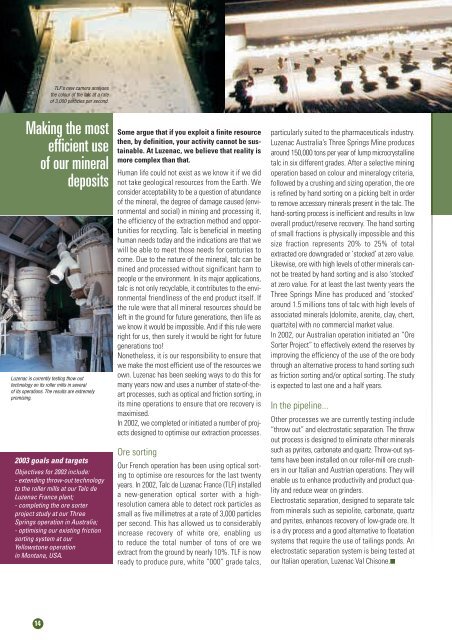
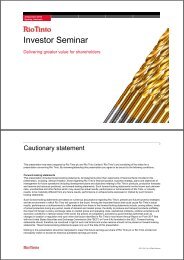


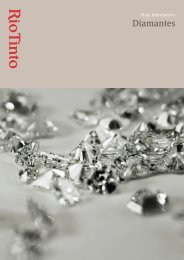

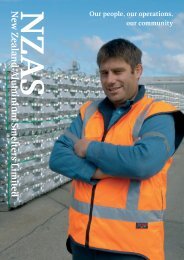
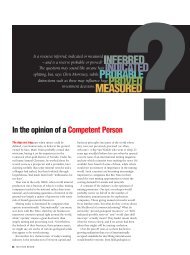
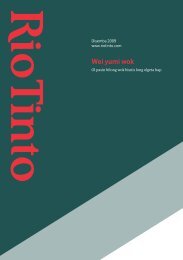

![Download pdf file [PDF: 1.26 MB] - Rio Tinto](https://img.yumpu.com/10319684/1/190x253/download-pdf-file-pdf-126-mb-rio-tinto.jpg?quality=85)

